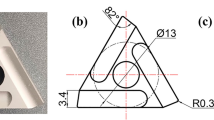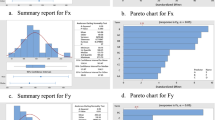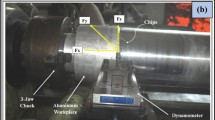Abstract
Machining of steel-based alloy (STAVAX) and tungsten carbide (WC) is very challenging due to their superior hardness. Severe wear in the machining of the die materials is the dominant problem. Texturing on the rake face of the tool and ultrasonic elliptical vibration cutting (UEVC) may resolve this issue and could prolong tool life. The patterns on the rake face of the tool entrap the chip and debris created in machining and prevent abrasion. During UEVC the flank face of the tool does not contact the workpiece and the rake face of the tool helps the chip evacuate from the machining area when the tool disengages with the workpiece. Thus, UEVC reduces cutting force and tool wear compared to conventional cutting. This paper investigates the cutting performance and tool wear in machining of the die materials with textured polycrystalline diamond (PCD) tools under UEVC. The linear patterns parallel or perpendicular to the chip flow are engraved on the rake face of the PCD tools with the focus ion beam (FIB) process. Orthogonal cutting experiments are carried out on ultra-precision machine tools with and without UEVC. Machining under UEVC remarkably reduces the cutting and thrust force and improves tool life. For machining of STAVAX with the textured PCD tool, the linear patterns alone do not improve the cutting, but they improve the cutting when they are combined with UEVC. In machining of WC, the linear pattern becomes effective by slightly decreasing the thrust force and friction coefficient when UEVC is not applied.













Similar content being viewed by others
References
Zhan, Z., He, N., Li, L., Shrestha, R., Liu, J., & Wang, S. (2015). Precision milling of tungsten carbide with micro PCD milling tool. The International Journal of Advanced Manufacturing Technology, 77(9), 2095–2103. https://doi.org/10.1007/s00170-014-6632-7
Ding, X., Liew, W. Y. H., Ngoi, B. K. A., Gan, J. G. K., & Yeo, S. H. (2002). Wear of CBN tools in ultra-precision machining of STAVAX. Tribology Letters, 12(1), 3–12. https://doi.org/10.1023/A:1013987708701
Zhao, Y., Yue, W., Lin, F., Wang, C., & Wu, Z. (2015). Friction and wear behaviors of polycrystalline diamond under vacuum conditions. International Journal of Refractory Metals and Hard Materials, 50, 43–52. https://doi.org/10.1016/j.ijrmhm.2014.11.008
Hao, X., Cui, W., Li, L., Li, H., Khan, A. M., & He, N. (2018). Cutting performance of textured polycrystalline diamond tools with composite lyophilic/lyophobic wettabilities. Journal of Materials Processing Technology, 260, 1–8. https://doi.org/10.1016/j.jmatprotec.2018.04.049
Kim, D. M., Bajpai, V., Kim, B. H., & Park, H. W. (2015). Finite element modeling of hard turning process via a micro-textured tool. The International Journal of Advanced Manufacturing Technology, 78(9), 1393–1405. https://doi.org/10.1007/s00170-014-6747-x
Kawasegi, N., Ozaki, K., Morita, N., Nishimura, K., & Yamaguchi, M. (2017). Development and machining performance of a textured diamond cutting tool fabricated with a focused ion beam and heat treatment. Precision Engineering, 47, 311–320. https://doi.org/10.1016/j.precisioneng.2016.09.005
Kang, Z., Fu, Y., Chen, Y., Ji, J., Fu, H., Wang, S., & Li, R. (2018). Experimental investigation of concave and convex micro-textures for improving anti-adhesion property of cutting tool in dry finish cutting. International Journal of Precision Engineering and Manufacturing-Green Technology, 5(5), 583–591. https://doi.org/10.1007/s40684-018-0060-3
Lian, Y., Chen, H., & Mu, C. (2019). Performance of microtextured tools fabricated by inductively coupled plasma etching in dry cutting tests on medium carbon steel workpieces. International Journal of Precision Engineering and Manufacturing-Green Technology, 6(2), 175–188. https://doi.org/10.1007/s40684-019-00088-3
Zhang, K., Guo, X., Wang, C., Meng, X., Sun, L., & Xing, Y. (2020). Effect of scale and sequence of surface textures on the anti-adhesive wear performance of PVD coated tool in dry machining SLM-produced stainless steel. International Journal of Precision Engineering and Manufacturing-Green Technology. https://doi.org/10.1007/s40684-020-00233-3
Maeng, S., & Min, S. (2020). Dry ultra-precision machining of tungsten carbide with patterned nano PCD tool. Procedia Manufacturing, 48, 452–456. https://doi.org/10.1016/j.promfg.2020.05.068
Shamoto, E., & Moriwaki, T. (1994). Study on elliptical vibration cutting. CIRP Annals, 43(1), 35–38. https://doi.org/10.1016/S0007-8506(07)62158-1
Shamoto, E., & Moriwaki, T. (1999). Ultaprecision diamond cutting of hardened steel by applying elliptical vibration cutting. CIRP Annals, 48(1), 441–444. https://doi.org/10.1016/S0007-8506(07)63222-3
Kim, G. D., & Loh, B. G. (2011). Direct machining of micro patterns on nickel alloy and mold steel by vibration assisted cutting. International Journal of Precision Engineering and Manufacturing, 12(4), 583–588. https://doi.org/10.1007/s12541-011-0075-y
Liu, K., Li, X. P., Rahman, M., & Liu, X. D. (2004). Study of ductile mode cutting in grooving of tungsten carbide with and without ultrasonic vibration assistance. The International Journal of Advanced Manufacturing Technology, 24(5), 389–394. https://doi.org/10.1007/s00170-003-1647-5
Suzuki, N., Haritani, M., Yang, J., Hino, R., & Shamoto, E. (2007). Elliptical vibration cutting of tungsten alloy molds for optical glass parts. CIRP Annals, 56(1), 127–130. https://doi.org/10.1016/j.cirp.2007.05.032
Brehl, D. E., & Dow, T. A. (2008). Review of vibration-assisted machining. Precision Engineering, 32(3), 153–172. https://doi.org/10.1016/j.precisioneng.2007.08.003
Jung, H., Hayasaka, T., & Shamoto, E. (2018). Study on process monitoring of elliptical vibration cutting by utilizing internal data in ultrasonic elliptical vibration device. International Journal of Precision Engineering and Manufacturing-Green Technology, 5(5), 571–581. https://doi.org/10.1007/s40684-018-0059-9
Jiang, C., Wu, T., Ye, H., Cheng, J., & Hao, Y. (2019). Estimation of energy and time savings in optical glass manufacturing when using ultrasonic vibration-assisted grinding. International Journal of Precision Engineering and Manufacturing-Green Technology, 6(1), 1–9. https://doi.org/10.1007/s40684-019-00022-7
Zhang, J., Rosenkranz, A., Zhang, J., Guo, J., Li, X., Chen, X., Xiao, J., & Xu, J. (2021). Modified wettability of micro-structured steel surfaces fabricated by elliptical vibration diamond cutting. International Journal of Precision Engineering and Manufacturing-Green Technology. https://doi.org/10.1007/s40684-021-00358-z
Shimada, S., Tanaka, H., Higuchi, M., Yamaguchi, T., Honda, S., & Obata, K. (2004). Thermochemical wear mechanisms in machining of ferrous metals. CIRP Annals, 53(1), 57–60. https://doi.org/10.1016/S0007-8506(07)60644-1
Acknowledgements
The authors gratefully acknowledge the financial support and the donation of the ROBONANO α-0iB to MIN LAB at UW-Madison from the FANUC Corporation, Japan (MSN240845) and Sumitomo Electric Carbide, Japan for providing the diamond tools as well as the financial support from Hongik University.
Author information
Authors and Affiliations
Corresponding authors
Additional information
Publisher's Note
Springer Nature remains neutral with regard to jurisdictional claims in published maps and institutional affiliations.
Rights and permissions
About this article
Cite this article
Maeng, S., Ito, H., Kakinuma, Y. et al. Study on Cutting Force and Tool Wear in Machining of Die Materials with Textured PCD Tools Under Ultrasonic Elliptical Vibration. Int. J. of Precis. Eng. and Manuf.-Green Tech. 10, 35–44 (2023). https://doi.org/10.1007/s40684-022-00416-0
Received:
Revised:
Accepted:
Published:
Issue Date:
DOI: https://doi.org/10.1007/s40684-022-00416-0




